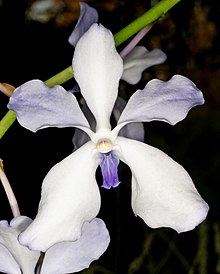
Vanda

Vanda is a genus in the orchid family, Orchidaceae. There are about 80 species, and the genus is commonly cultivated for the marketplace. This genus and its allies are considered to be among the most specifically adapted of all orchids within the Orchidaceae. The genus is highly prized in horticulture for its showy, fragrant, long-lasting, and intensely colorful flowers. Vanda species are widespread across East Asia, Southeast Asia, and New Guinea, with a few species extending into Queensland and some of the islands of the western Pacific. The name 'Vanda' is derived from the Sanskrit (वन्दाका) name for the species Vanda roxburghii(Synonym of Vanda tessellata). These mostly epiphytic, but sometimes lithophytic or terrestrial orchids, are distributed in India, Himalaya, Southeast Asia, Indonesia, the Philippines, New Guinea, southern China, and northern Australia. The genus has a monopodial growth habit with highly variable leaves according to habitat. Some have flat, typically broad, ovoid leaves (strap-leaves), while others have cylindrical (terete), fleshy leaves and are adapted to dry periods. The stems of these orchids vary considerably in size; some are miniature plants and some have a length of several meters. The plants can become quite massive in habitat and in cultivation, and epiphytic species possess very large, rambling aerial root systems. The few to many flattened flowers grow on a lateral inflorescence. Most show a yellow-brown color with brown markings, but they also appear in white, green, orange, red, and burgundy shades. The lip has a small spur. Vanda species usually bloom every few months and the flowers last for two to three weeks. Many Vanda orchids (especially V. coerulea) are endangered, and have never been common because they are usually only infrequently encountered in habitat and grow only in disturbed forest areas with high light levels, and are severely threatened and vulnerable to habitat destruction. The export of wild-collected specimens of the blue orchid (V. coerulea) and other wild Vanda species is prohibited worldwide, as all orchids are listed on Appendix II of the Convention on International Trade in Endangered Species. This genus is one of the five most horticulturally important orchid genera, because it has some of the most magnificent flowers to be found in the orchid family. This has contributed much to the work of hybridists producing flowers for the cut flower market. V. coerulea is one of the few botanical orchids which can produce varieties with blue flowers (actually a very bluish purple), a property much appreciated for producing interspecific and intergeneric hybrids. The color blue is rare among orchids, and only Thelymitra crinita, a terrestrial species from Australia, produces flowers that are truly 'blue' among the orchids, the other being Aganisia cyanea, a lowland species from northern South America that is difficult to cultivate, but has metallic blue flowers. Both of these species, much like Vanda, also have a bluish-purple tint towards the inner petals of the flowers.
